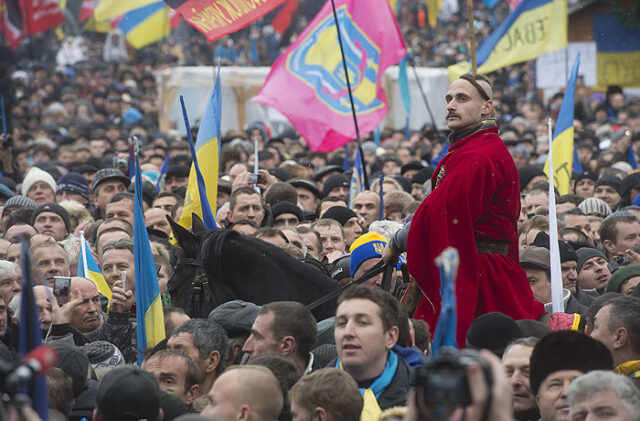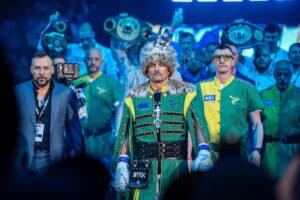
Cossacks Provide a Source of Strength for Ukraine
Publication: Eurasia Daily Monitor Volume: 21 Issue: 78
By:

Executive Summary:
- Ukrainian Cossack societies have played a growing role in preparing the next generation of Ukrainians for military service since 2014 by teaching children combat skills.
- Cossack culture and military service have a long-standing relationship in Ukraine, with military formations and soldiers regularly invoking Cossack imagery.
- Ukrainian Cossack organizations have been a potent contributor to Ukraine’s defense in organizing resistance without much government aid or direction.
Ukraine’s anthem calls it “the Cossack nation,” and Ukrainian Cossacks have made significant contributions to the country’s defense against Russian forces. For Russia, self-described, state-registered “Cossack” paramilitary organizations have been a significant part of the war effort (see EDM January 16, February 27, May 1). While there is debate about their origins, most Ukrainian historiography claims the Cossacks were descendants of slaves freed from the Crimean Khanate. By the 16th century, they had become numerous enough to establish a Cossack host centered in Zaporizhzhia (on the present-day frontlines) and the river island of Khortysta, where they established a sich (or palisade). A modern-day replica of the sich was begun in 2004 and finished in 2010 (Khortytsa guide, accessed May 12). The distinction between the role of Russian Cossacks and Ukrainian Cossacks in the war demonstrates what each side is fighting for. The importance of cultural history for the Ukrainian Cossacks provides motivation for them to defend their homeland, meaning they have more of a reason to fight than the Russian invaders.
These Zaporizhian Cossacks were distinct from those who settled around Rostov and allied with the Russian tsar, the ancestors of today’s Russian state-registered Cossack movement. The Zaporizhian Cossacks would work as mercenaries for the Russian tsar, Polish king, and Turkish Sultan. Eventually, the Cossacks established the first proto-state in Ukraine, the Hetmanate, in 1648 under Bogdan Kh’melnitsky, widely regarded as the founding father of Ukraine. During a brief period of independence for Ukraine in 1918, President Pavlo Skoropadsky was allegedly a descendant of the Cossacks and used the title of hetman. Likewise, in 1990, one of the largest demonstrations for Ukrainian independence from the Soviet Union was held around the grave of Cossack Ataman Ivan Sirko. Called the “Days of Cossack Glory,” between 300,000 and 500,000 Ukrainians gathered to celebrate the 500th anniversary of the founding of the Cossack host (Radio Svoboda, August 24, 2023). The continued poignancy of this festival is shown by the Russian occupiers in Mariupol destroying a monument erected to the “Days of Cossack Glory” in April, seeking to eradicate vestiges of independent Ukrainian history (Kyiv Post, April 22). Most recently, Cossack culture was on display on May 18, when Ukrainian heavyweight boxing champion Oleksandr Usyk walked into his fight with British boxer Tyson Fury wearing full Cossack regalia (Twitter.com/Biz_Ukraine, May 19).

Ukrainian Cossack organizations play an independent role in preparing the next generation of soldiers for Ukraine’s army. For example, in 2019, summer camps near Odesa and Zaporizhzhia employed Cossack symbolism in raising their children and led Cossack-themed games, often with a distinct military feel. This continues, with Jura continuing to teach children skills useful for military service. Not everyone can become a member of Jura. “Only those who were fit for Cossack service having passed physical and moral tests” can join (Facebook.com, May 27, 2023). Given expectations that Russia’s seems to be transitioning to conducting the “long war,” the importance of this pre-military training is not to be underestimated (see EDM, May 20).
Some Cossack societies began teaching military and self-defense training after the 2014 Euromaidan revolution. A Facebook post celebrating the tenth anniversary of the “beginning of the formation of the organization” celebrated operations “Watch,” “Intercession,” and “Cossack volunteer,” praising the work the organization has done since 2014 (Facebook.com, September 12, 2023). On May 6, the actual anniversary of the Cossack volunteer project was marked by the continuing participation of the organizers in recruiting more people to defend Ukraine (Facebook.com, May 6). In organizing resistance without much government aid or direction, Cossack organizations have been a potent contributor to Ukraine’s defense.
The main contribution of the Cossack idea in Ukraine seems to lie in its strong relationship with the military, as many soldiers present themselves as Cossacks. During the “anti-terrorist operation” in Donbas after 2014, many service members inked themselves with Cossack tattoos, presumably reflecting their proclaimed identity (Depo.ua, March 30, 2015). During this analyst’s travels to the region, he saw many displays of Cossack affiliations among the military, including stylized haircuts and other symbols.
Cossack influence on Ukrainian soldiers has grown more visible since 2022. Ukrainian soldier Yaroslav Shamanov’s obituary states that he learned the Cossack fighting style “Combat Hopak,” worked at Cossack children’s camps, and even cut his teeth commanding young Cossacks (Ukrinform.ua, November 7, 2022; EDM, January 9, 2023). Similarly, Artyom Sacharov of the “black Zaporzhye Cossacks” has discussed how this “renowned” unit is one of the best on the battlefield (YouTube, February 11, 2023). Despite the difficulty of evaluating this claim, the Cossack mantle is clearly a source of pride and motivation for the Ukrainian military. Furthermore, the Cossack is an image commonly invoked by Ukrainian soldiers interviewed by the media and a moniker taken up by some foreign volunteers, such as the “Spaghetti Kozak,” who fight alongside the Ukrainians (X.com/SpaghettiKozak, accessed May 12).
The close affiliation of the Ukrainian military with the Cossacks can be seen in two additional ways. First, in 1999, October 14 (also a religious festival in the Eastern Orthodox calendar) was declared the “Day of the Ukrainian Cossacks” (Zakon.ua, August 7, 1999). In 2014, it was also declared the “Day of the Defenders of Ukraine,” a holiday with clear military overtones (President.gov.ua, February 21, 2015). Second, a military band designed to inspire Ukrainian troops is called “The Horse Runs, The Cossack Sings,” and military formations including the 54th Mechanized Infantry have been renamed for such Cossack heroes as Ivan Mazeppa (zakon.rada.gov.ua, May 6, 2020; Ukrinform.ua, May 13). Whereas in Russia, the state-registered Cossacks are making war, in Ukraine, it seems the war is making Cossacks.



